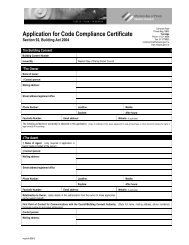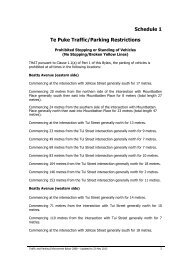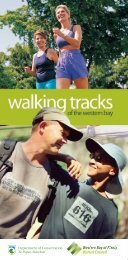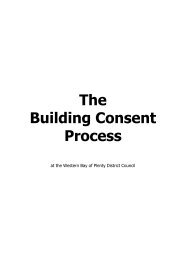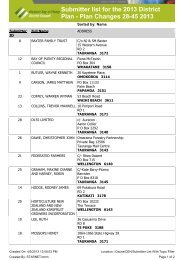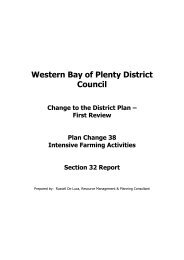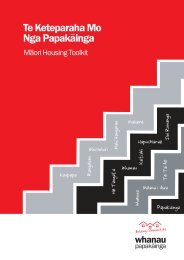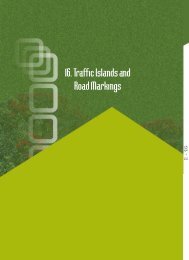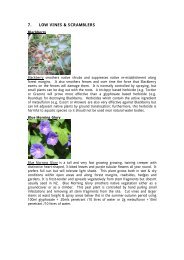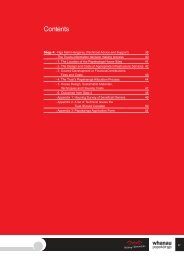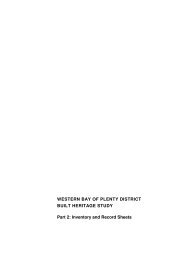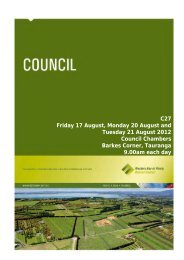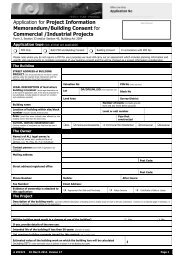Te Puna Plan - Western Bay of Plenty District Council
Te Puna Plan - Western Bay of Plenty District Council
Te Puna Plan - Western Bay of Plenty District Council
Create successful ePaper yourself
Turn your PDF publications into a flip-book with our unique Google optimized e-Paper software.
open spaces<br />
agriculture<br />
grazing animals<br />
market gardening<br />
plantations<br />
cropping<br />
sheds<br />
crop protection structures<br />
artificial housing<br />
vegetation (trees, shrubs and grasses) – both indigenous and exotic<br />
houses and outbuildings<br />
varying topography including rolling hills and steep gorges<br />
rivers and streams<br />
Michigan planning agencies 6 approach rural character from an individual’s perspective:<br />
Michigan's diverse landscapes, including its shorelines, riparian areas, open fields, forests, and<br />
farmlands, draw residents to a variety <strong>of</strong> rural areas throughout the state. Rural character is many<br />
times a perception unique to the individual. One person may interpret rural character as having a low<br />
density <strong>of</strong> development; another may only recognize it where there is a complete absence <strong>of</strong> manmade<br />
features, such as signs and buildings.<br />
But regardless <strong>of</strong> any individual interpretation <strong>of</strong> rural character, it remains true that as more people<br />
are attracted to rural areas, preserving the unique character <strong>of</strong> an area becomes more <strong>of</strong> a challenge.<br />
Ultimately, it is the community's own definition <strong>of</strong> rural character that is the single most important part<br />
<strong>of</strong> its preservation. It is up to each community to decide what its rural character is and subsequently,<br />
how it can be preserved. For example, definitions <strong>of</strong> rural character may include the following<br />
elements:<br />
<br />
<br />
<br />
<br />
<br />
<br />
<br />
<br />
<br />
tree-lined streets<br />
farmlands<br />
woodlands<br />
clean air and water<br />
undeveloped open space<br />
natural streambanks<br />
natural lake shorelines<br />
outdoor recreation opportunities<br />
small villages and communities.<br />
Closer to home, Wellington City <strong>Council</strong> 7 provides an interesting perspective on rural character that<br />
is community based.<br />
Horokiwi, north <strong>of</strong> Wellington, is a rugged high altitude area sparsely settled with dramatic outlook<br />
and climate. Community feedback signalled a great passion amongst residents and visitors for<br />
solitude and naturalness.<br />
The character was described in terms that reflect a rugged yet tranquil rural enclave. <strong>Council</strong>’s<br />
response to maintaining and enhancing this character was, amongst other things, to prepare a rural<br />
heritage plan including identifying cultural, historic and natural elements contributing to character and<br />
their sensitivity to change.<br />
Other key dimensions <strong>of</strong> rural character included ridgelines, landscapes and views, places <strong>of</strong> cultural<br />
and historic importance, native bush and wildlife, natural water bodies, and sustainable management<br />
practices.<br />
The most comprehensive local research relevant to ‘rural character’ is contained in SmartGrowth<br />
Rural Issues Background Report, August 2002 prepared by Harrison Grierson Consultants Ltd.<br />
The rural area <strong>of</strong> <strong>Western</strong> <strong>Bay</strong> sub-region is described as a physical environment (land forms and<br />
landscapes, soil types, land use capability, ecology and biodiversity and water catchment areas), a<br />
working environment (employment and economy) and a living environment (population, dwellings,<br />
past and present living environment for Maori, rural playground).<br />
The report goes on to state (p5):<br />
“The majority fo land within the <strong>Western</strong> <strong>Bay</strong> <strong>of</strong> <strong>Plenty</strong> sub-region is “rural” land. In simple terms, that<br />
is all the land that is not “urban” in nature (ie not “part” <strong>of</strong> a town or city). The rural area comprises a<br />
mixture <strong>of</strong> unmodified and modified elements (with the latter much more common today):<br />
Relatively unmodified elements<br />
conservation estate areas/reserves<br />
remnant areas <strong>of</strong> indigenous vegetation<br />
remnant wetlands<br />
Modified elements<br />
extensive farming areas<br />
intensive farming areas (agriculture, horticulture, cropping)<br />
houses associated with farming activities<br />
houses on lifestyle blocks<br />
rural infrastructure<br />
peri-urban activities (largely serving towns but needing a rural location – contractors yards,<br />
quarries, landfills, sewage treatment, and so on).<br />
6 Internet Reference } State the reference link<br />
7 Horokiwi Rural Community <strong>Plan</strong> }<br />
<strong>Te</strong> <strong>Puna</strong> Community <strong>Plan</strong> March 2007 Page 29



